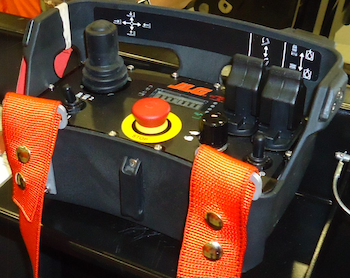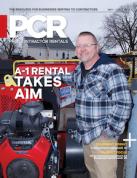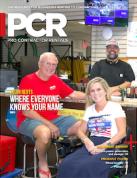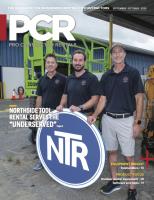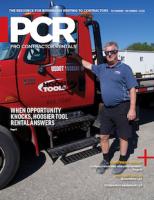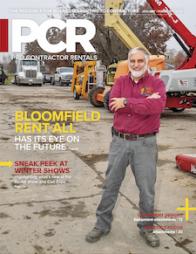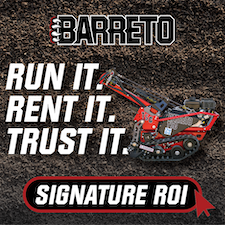Industry Outlook -- Trends in telehandlers
Lifting more at greater heights, new telehandler models are “smarter,” more productive and comfortable than previous models, opening revenue opportunities for rental centers.
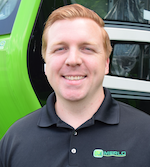 |
| Sales Manager AUSTIN BAILEY Merlo (AMS) |
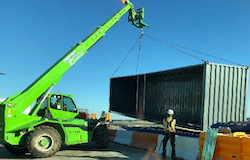 |
|
The Merlo P65.14 telescopic handler offers 14,000 pounds of lift capacity. |
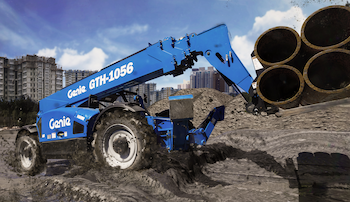 |
| The Genie GTH-1056 telehandler is outfitted with a continuously variable transmission that transfer more power to the ground than conventional transmissions. This allows it to be powered by a 74-horsepower DEF-free engine and has the equivalent power of a 120-horsepower engine. Exclusive Enduro A/T tires offer 30 percent longer tire life than typical rough-terrain tires. |
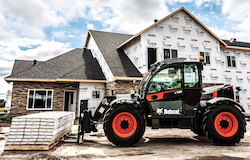 |
| With less open space, new buildings are becoming taller and placed closer together. This is driving higher demand for smaller footprint telehandlers, such as the SkyTrak 3013. |
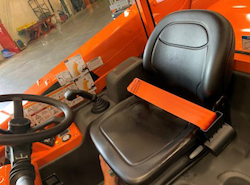 |
| The Seatbelt Engagement and Operator Presence option for JLG 742, 943, 1043, 1055 and 1255 telehandler models features a high-visibility orange seatbelt, visual and audible alarms, and limits on machine functions if the seatbelt is not engaged. |
|
|
| The JLG remote boom control enables operators to control the telehandler’s boom from outside the cab, giving operators improved visibility during load placement. |
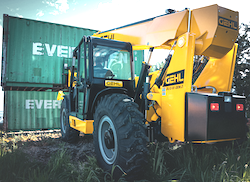 |
| Masonry, framing, steel erection, roofing have different equipment preferences, so rental centers in the market to expand their telehandler fleets should match equipment purchases with the work and tasks needed in your local market. |
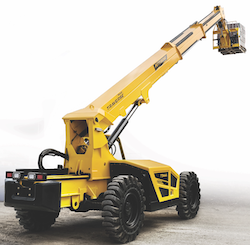 |
| Pettibone Traverse telehandlers can lift loads evenly up to full height without tricky hand work to keep the load level. |
Technology increases safety and efficiency
Merlo has introduced more models engineered for higher lift heights and more capacity to meet contractor requests for more weight at greater heights.
In addition to more models, these units come packed with technology.
Merlo’s Eco Power Drive (EPD) is a control system that adjusts the engine speed based on the operating conditions. It reduces fuel consumption by up to 18 percent, which translates into dollars saved.
Merlo’s maintains high safety standards and consistently looks for ways to build better safety into every machine without sacrificing productivity. This is especially true with its overload protection systems. Merlo’s load moment indicators (L.M.I.) offer real-time feedback, which is not common with many telehandler models.
When a rental center looks to add new lines or enhance its current product offerings, it can take one of two paths: It can take the easiest path and pick up units that are similar or the same to what others in the area are providing in hopes of grabbing some of that market share. Or, it can do the research to be different.
Ask your key customers what their optimal piece of equipment would be like. Pay attention to the queries that come through the rental desk. From that, explore becoming the business that does not carry what everyone else has. Become that business that has what others do not.
Many familiar telehandlers utilized by contractors fall into the 8,000-, 10,000- and12,000-pound capacity range. Adding other telehandlers that go beyond the expected, such as a Merlo P65.14 (14,000 pounds) and the P120.10 (26,500 pounds) could be what separates one rental center from the others. Adding this size of machines could produce a better ROI because few rental centers offer these capacities.
To gain rental business, the sales team needs to do more than just hand over the rental forms to be signed. They need ongoing training and have information on all aspects of the machinery available. What can it do? How does it work? What safety features are offered? What about attachments? Set yourself apart from others by offering onsite training. Also, service the machines if you can provide roadside assistance.
A rental center may also be able to increase demand by holding regular ‘meet and greets’ at customers’ sites whenever new equipment is added to the fleet. Invite key accounts and others who have expressed interest and do demos. It’s always a good idea to have a manufacturer rep available, if possible, to handle any technical questions.
Marketing Manager
JASON BOERGER
Bobcat Co.
The need for speed (management)
We are seeing improvements in productivity with hydraulic-powered attachments. For example, speed management is a feature that adjusts travel speed independently from engine speed, allowing the operator to dial in a desired travel speed, ultimately improving efficiency, especially with attachments that require slow and consistent travel speeds.
Inching control is a way to enable precision at slower speeds while maintaining power. By depressing the brake pedal halfway, operators can quickly cut travel speed while sustaining the engine throttle. This inching control destrokes the drive pump to reduce drive speed without reducing power to the attachment – enabling slower, more precise control without sacrificing productivity.
Another advance is the Smart Handling System on Bobcat telehandlers. This feature combines productivity and precision, allowing the operator to set the boom speed for lifting, telescoping and tilting, adapting the machine to the task at hand. It’s ideal for achieving precise boom motion when the job demands high-rpm performance.
Operator comfort has improved as well. Operators often work many hours a day in a telehandler and feeling good when the work is done is important. Bobcat telehandlers offer roomy, fully enclosed climate-controlled cabs, allowing operators to work in comfort all year long. The low-profile boom sits below the operator’s eye level to provide an optimal view of the surroundings; front, top and rear window wipers clear away moisture and minimize the buildup of dust, debris and mud. Multiple mirrors on the operator’s left and right assist him or her when working in confined areas.
Servicing the machine is an important factor to consider when investing in any piece of equipment. Bobcat knows rental centers and renters want the equipment to be out working and not spending extra time gaining access to machine components for maintenance. Bobcat telehandlers have a side-mounted engine that puts routine maintenance checks, filters and other engine components within easy reach. The side-by-side mounted radiator, oil cooler and fan provide a clean engine compartment layout for easy access. Dirt and debris removal is quick and simple whenever cleaning is necessary. The remote oil filter location provides easy access to the oil filter, within reach of other service points for simple, fast oil changes.
Nylon wear pads on the inside corners of the extendable boom allow for better guidance and reduce free play of the boom. They’re easily adjusted and require minimal servicing and greasing. Another advantage is the commonality of parts with other Bobcat products.
Bobcat Machine IQ telematics is available for all Bobcat telehandlers. Machine IQ wireless communications connects to a machine’s information anytime, anywhere, from any device. Machine IQ allows rental centers to check on machine health and remotely track information that enhances maintenance, security and performance. This information helps discover and address unplanned maintenance issues, create a planned maintenance program based on machine use, track machines’ location and how they’re allocated, manage the expectations of machine usage and receive notifications if your machine is misused or misplaced, and analyze efficiency and productivity for your fleet. This information can be accessed anytime via a Bobcat Owner Portal account at my.Bobcat.com.
To get added rental revenue, promote the versatility of these types of machines. There are many attachments that work with Bobcat telehandlers. Select Bobcat telehandlers share the Bob-Tach attachment mounting system, so users can utilize several attachments traditionally stocked for use with other Bobcat products. Having a telehandler paired with multiple attachments in the rental center’s compact equipment fleet will help increase demand and ROI on telehandlers and attachments.
High lift heights and impressive reach are highlights of telehandlers that renters need to know about and showing the impressive capacities and capabilities of these machines is a great selling point.
Being able to offer one piece of equipment that is versatile, compact, offers a small footprint and impressive lift and reach capability make it a very attractive rental piece of equipment.
 |
|
Product Manager-Telehandlers |
CVT transmissions and smaller engines increase fuel efficiency
The latest Genie telehandler, the GTH-1056, offers the option of a 74-horsepower DEF-free engine that can be configured with an optional continuously variable transmission (CVT). The CVT improves efficiency by transferring more engine power to the drivetrain, when compared with a powershift transmission. Together, the 74-horsepower engine and CVT provide comparable drawbar pull to a 120-horsepower engine and powershift transmission, but without the need for DEF or aftertreatment. The end result is a more fuel-efficient machine that requires less engine maintenance and a lower total cost of ownership.
Telehandlers are extremely versatile machines that fit many applications, which helps rental centers with utilization. Knowing what types of projects are happening in the area and what machines are good fits for those projects will help a rental center best determine the telehandlers that fit their fleets.
One thing that Genie salespeople emphasize consistently is keeping up on scheduled maintenance. This includes everything from the daily walk-around inspections to regular filter and fluid changes. The old adage, “An ounce of prevention is worth a pound of cure,” certainly applies. Genie telehandlers have side-mounted engines that allow unobstructed access to common service points so customers can quickly check for rental readiness.
When Genie introduced the new GTH-1056 telehandler earlier in 2021, it also launched Genie’s exclusive Enduro A/T tire, a hybrid all-terrain tire that provides up to 30 percent longer tire life than a typical rough-terrain tire. The Enduro A/T can significantly improve ROI over the life of the machine.
 |
|
Senior Product Manager, Telehandlers |
Technology improves productivity and safety
Advances that increase operator confidence and productivity and drive safety improvements on job sites have influenced JLG and SkyTrak product development. JLG is committed to understanding customers’ job site challenges and partnering with them to develop solutions that deliver tangible benefits. As JLG engineers develop new features and functionality, it is a result of our teams watching how telehandlers work on job sites and talking with operators that use this equipment every day. This input ensures that when JLG launches a product, it’s the right solution that solves these unmet needs.
Some of our latest telehandler features based on our voice-of-the-customer work include a Seatbelt Engagement and Operator Presence option for JLG 742, 943, 1043, 1055 and 1255 telehandler models features a high-visibility orange seatbelt, visual and audible alarms, and limits on machine functions if the seatbelt is not engaged to enhance safety during telehandler operation.
The Load Stability Indication (LSI) system aids operators by helping them remain within the longitudinal or forward load capacity of the telehandler. Another safety feature is JLG’s multi-reverse camera system that helps operators see a broader area – left, right and rear – on the backside of the machine, giving operators more confidence when backing up.
The JLG remote boom control enables operators to control the telehandler’s boom from outside the cab, giving operators improved visibility during load placement.
From a machine standpoint, attachments continue to enhance the versatility of the telehandler, as well as the productivity of the operator. Offering new tools for the front-end of the machine can create many job site benefits. The most recent attachment introductions have been in the “specialty” category; one example of this is the new JLG sheet material handler attachment, which gives operators the ability to confidently lift and place sheetrock, drywall, plywood, green board and other sheet materials from an upright position instead of lifting each piece individually from ground level.
When considering adding new model telehandlers into a rental fleet, it is important for rental centers to understand the particular wants and needs of the local customer base. Do they need/want models with higher reach or more compact models? Are they looking for models with new technology to help improve job site efficiencies and are willing to pay a higher rental rate for machines with these features? Or are they looking for basic models that lift and place with limited technology? All of these things should be taken into consideration prior to investing.
Once the purchase decisions are made and new models are added to a fleet, the rental company and its sales team must learn what the new model and any associated technology offers not only their business, but also how those features benefit customers’ businesses. The better job one does communicating the advantages of the new models, the more likely customers will be to request them, accelerating the user adoption rate. Bringing on models with new technology will also require training for service personnel. It’s crucial to maintain a high level of customer support.
Several construction trends ae impacting design, development, features, functions and benefits of construction equipment, including telehandlers. Urbanization is one of those trends, with less open space. New buildings are becoming taller and placed closer together. This is driving higher demand for smaller footprint telehandlers, like the SkyTrak 3013, and taller models such as the JLG 1075.
The global focus on reducing emissions produced by off-highway construction equipment, including telehandlers, continues to expand. Electrification is a trend that is just starting to gain traction and will be one to watch moving forward.
Another trend affecting telehandler and other equipment development is the move toward more connected job sites. The Internet of Things (IoT) is changing how equipment interacts with manufacturers, distributors, owners, operators and technicians. For end users, it can provide valuable data throughout the workday for decision-making and planning purposes. For rental companies, this connectivity can help improve fleet utilization, maintenance, serviceability, and uptime.
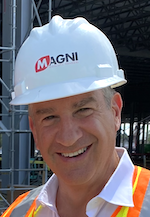 |
|
Chief Operating Officer |
Rotating telehandlers gaining popularity
Three key advances are incorporated into Magni rotating telehandlers: increased productivity, efficiency, safety and profits for end users. Rotating telehandlers cam can replace multiple machines (telehandler, rough-terrain crane and aerial work platforms. This is getting considerable end-user interest. Magni rotating telehandlers are not a commodity product so they offer dealers the ability to achieve higher margins and utilization rates.
Magni offers 16 models in its rotating lineup with lift heights from 57 to 167 feet and lifting capacities from 8,800 to 28,600 pounds. As end users need to lift higher and heavier loads, they will find a Magni unit that can meet that need. Magni also offers the safest machines available in their product categories; every machine incorporates a full LMI, load-limiting system to ensure operator safety.
Like any product, bringing on a new line of telehandlers needs to represent a solid business decision for the rental center. Is it complementary to your existing product offerings and customer base? Does the product allow the rental center to distinguish itself in the market – is it a game changer – is it unique? Does it provide customers with excellent value? What is the competitive nature of the product?
Magni is the world leader in rotating and heavy-lift telehandlers and provides dealers with a unique product offering that can be utilized on most any job site. Magni models are unrivaled in terms of lifting capacity and heights, and in many segments, have no competition. By providing the highest levels of productivity, efficiency and safety along with increased profits, Magni units allow the dealer to offer customers tremendous value.
As important is the company’s commitment to and availability of parts and service from the manufacturer. Is the company fully committed to ensuring the highest utilization possible for its dealers? Is there marketing support to help drive the business? Is there sales training beyond product familiarization to ensure your sales team can handle any challenge? Magni has multiple parts distribution facilities in the United States, a large team of factory-trained service support people who are available 24/7, and available education via in-person and online for its dealers.
Many strategies can be used to further increase demand. These include demo days, marketing videos that truly show the value proposition, and employing a well-trained staff who can communicate both features and benefits can greatly increase equipment demand. Because Magni units are not a commodity product and have very little, if any, competition, along with the value proposition for end-users, dealers are easily able to achieve a higher ROI with Magni telehandlers than with other brands of telehandlers.
 |
| Telescopic Handler Product Manager STEVE KISKUNAS Manitou Group |
New models offer more muscle
Technology updates, new product sizes and new operator assistance functions are three areas where new telehandlers are answering customer needs. Technology updates are not just having a Bluetooth radio that can connect to your favorite streaming service, but also a machine connected to the internet that provides real-time updates on the status, location and maintenance reminders for the telescopic handler.
New telehandler models range from the super-compact Gehl RS4-14/Manitou MT 420 to larger models of rotating telehandlers such as the Manitou MRT 3570 that has a 114-foot lifting capacity. These new products can offer material placement solutions for contractors where previous telehandlers could not go or reach. The new Manitou MT 730 H features a 6 foot 6 inch wide and 6 foot 6 inch tall profile while providing a 6,600-pound capacity to lift zones above 22 feet. This model has a compact size without sacrificing capacity. For higher lifting needs, the MT 930 has the same base machine, but lifts to 29 feet.
New operator assistance functions can be found on the Manitou MLT range telehandlers that feature return to work, bucket shaker and vertical lift functions. Easily activated by the operator, these functions replace complicated maneuvers with a simple joystick control operation to reduce operator fatigue and improve machine performance. Also, new gravity lowering systems, such as the regenerative hydraulic systems found on the Manitou MLT units, provide quick cycle times and improved power management of the machine.
Telescopic handlers are well-established construction tools that are well understood in the marketplace for providing the muscle for job site construction material placement. For rental centers looking to add telescopic handlers to their equipment fleets, they should first investigate the type of construction and equipment used in their local markets. There are regional preferences on telehandler capacity and sizes and preferences based on the type of work. Masonry, framing, steel erection and roofing have different preferences, so rental centers in the market to expand their telehandler fleets should match equipment purchases with the work and tasks needed in your local market.
One other item to consider is transportation. How large is the telehandler, and will your customers move it or will you be delivering the machines to customer sites? The Manitou MT 730 H is less than 13,000 pounds and can be moved with most standard equipment trailers. The Gehl RS6-34 is also a popular rental telehandler due to its 6,000-pound lift capacity, 34-foot lift height and 15,000-pound vehicle weight, so it can be transported with most standard equipment.
Equipment utilization and uptime are the key metrics to increasing ROI. To increase telehandler uptime, invest in service and parts team training. This assures the product is working and generating income and cash flow back to the equipment rental business. Stocking common service parts helps as a same-day repair vs. the machine being down for a number of days. It increases customer satisfaction with the equipment and your company and also increases rental center revenue.
To increase demand, review the list of attachments the rental center offers for telehandler products. While the most popular attachment are carriage and forks, additional attachments are available that can make the telehandler a tool carrier. Buckets, sweepers, truss booms and work platforms are some of the additional attachments that can be used to increase the tasks the telehandler completes while increasing the amount of time the customer will be renting the machine.
 |
|
Marketing Manager |
Telematics helps improve productivity and ROI
New telematics technologies are continuing to make it easier for rental centers to track their telehandler fleets, have a better understanding of utilization rates and ultimately save money by increasing uptime and saving time on unnecessary service calls for issues that can be remotely diagnosed.
Pettibone offers X-Command, a new telematics program that comes standard for two years on Pettibone X-Series Extendo and Traverse telehandlers. The system can also be retrofitted for existing X-Series machines. X-Command allows owners to look at current equipment data and generate reports that can assist with planning fleet maintenance.
With real-time access to the status of a telehandler equipped with telematics, many potential issues can be caught and avoided before they can become serious issues. Maintenance alerts can cover anything from notifying you that it’s time for a 2,000-hour inspection, to checking battery voltage, to remotely diagnosing an engine error code. Equipment owners can also simply check to ensure their machines are located where expected.
Some issues can be troubleshooted remotely using the telematics dashboard on a computer or smartphone app. This is particularly advantageous when a telehandler is on a far-away jobsite. Instead of service technicians driving two hours to check on an unknown issue, the problem can be potentially diagnosed and solved with a few taps on a screen.
In other situations, an equipment problem may require an on-site service call, but the field technicians responding will have more information about the problem. In fact, depending on the affected components, telematics can identify the exact part number that needs replacing, so technicians can ensure they have the necessary replacement part before heading to the job site to make the repair.
Many rental customers – even those very experienced with telehandlers – aren’t always familiar with a particular brand or model, so operator errors that lead to costly breakdowns are possible. Having telematics send proper alerts can go a long way toward proactively ensuring the customer’s uptime on a particular project and the long-term health of the telehandler in your fleet.
All of these factors contribute to money savings. Whether it’s decreased service labor, reduced travel time to job sites, avoiding maintenance issues from manifesting, or having a clearer picture of the condition of your telehandler fleet, telematics will increase the return on rental center investment.
Another consideration for rental centers looking to add telehandler units to their fleet is the warranty offered by the manufacturer. Many warranties look similar on the surface, but some may cut off after a certain number of hours of use, while others are good for the full warranty term regardless of how much they’ve been run.
Today’s telehandlers are equipped with many creature comforts and intuitive operator stations as well, which can be good selling points for rental customer who walk in the door.
Pettibone continues to be the only manufacturer producing a telehandler with a horizontally sliding boom. All models in the Pettibone Traverse lineup offer up to 70 inches of traversing boom travel. This allows users to safely land loads without having to coordinate multiple boom functions or move the machine physically forward or back, which can be hazardous, particularly on rough terrain.
The other advantage provided by Traverse units is that the landing height actually matches the specified maximum lift height for the machine. With a traditional fixed boom unit, the landing height can be a few feet lower than the advertised lift height, based on the fork positioning needed to land a load at height.
Captions:


